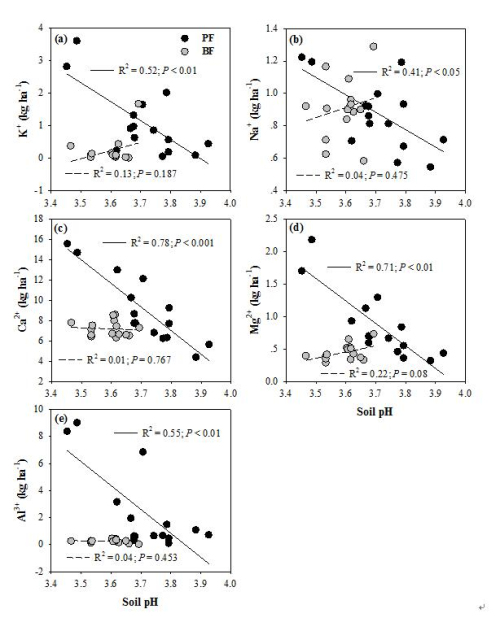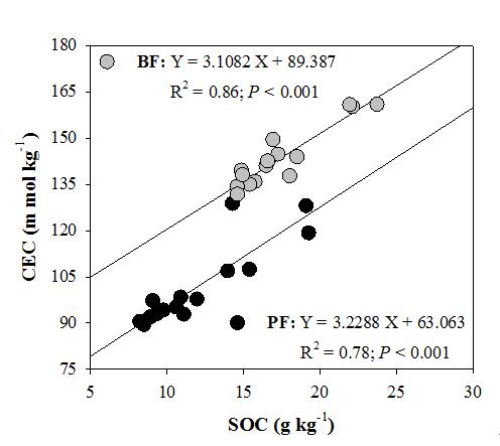

Getting here
Mechanisms of acid buffering in acidic forest soils in southern China
Elevated anthropogenic acid deposition has accelerated forest soil acidification in southern China. However, the observed responses to increased acid inputs are quite variable among different forest soils. Long-term observation data showed that the pH of an old evergreen broadleaved forest (BF) soils maintained around 3.8 under high rate of acid deposition over the last 16 years. By contrast, the pH of a young pine forest (PF) soils in the same study area significantly decreased over the same period.
To study the causes for the different responses of the two forest soils, Jun Jiang, a postdoctoral researcher in the research group of land surfaces biogeochemical cycles (Principal Investigator: Ying-Ping Wang), conducted a leaching experiment using soil columns taken from the PF and BF. Results showed that the PF soils were quite acid-sensitive, and the high acid treatment significantly decreased soil pH at 0-20 cm soil layer while significantly increased exchangeable H+ at both 0-20 and 20-40 cm soil layers. Both the low and high acid treatments significantly increased exchangeable Na+ at 0-20 cm soil layer and Ca2+ and Mg2+ at 20-40 cm soil layer. Furthermore, the high acid treatment also significantly increased leaching losses of H+, Ca2+, Mg2+ and Al3+. In contrast, the BF soils were able to buffer both the low and high acid treatments without significantly decreasing soil pH and increasing major exchangeable cations including Al3+ and their leaching losses. The significant differences in soil organic matter content were found to be responsible for these different responses, as a result of significantly positive correlation between cation exchange capacity (CEC) and organic carbon in both forest soils. The BF soils had higher organic matter than the PF soils, therefore a greater CEC for consuming H+ and a stronger capacity for binding cations. This study highlighted the important roles of soil organic matter in acid buffering and retaining of major cations, especially for Al3+ in the very acidic forest soils in southern China.
This study entitled “Soil organic matter is important for acid buffering and reducing aluminum leaching from acidic forest soils” and was published online recently in Chemical Geology (https://doi.org/10.1016/j.chemgeo.2018.10.009). Jun Jiang was the first author of the paper, and Professor Junhua Yan was the corresponding author. This study was by the National Science Fund for Distinguished Young Scholars (41825020) and the National Natural Science Foundation of China (31270557).

Fig.1 Relationships between soil pH and leaching losses of cations across all treatments along the whole soil profiles (0-40 cm) for the PF and BF, respectively.

Fig.2 Relationships between soil organic carbon (SOC) and cation exchange capacity (CEC) across all treatments along the whole soil profiles (0-40 cm) for the PF and BF, respectively.

Tel:0086-20-38314070 Email:yuyan@scbg.ac.cn
Address:No.723,Xingke Road,Tianhe District,Guangzhou,China Postcode:510650
Copyright©South China Botanical Garden All Right Reserved, Powered by scbg.ac.cn



